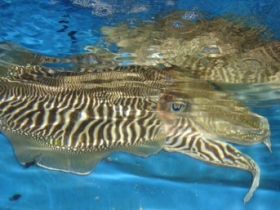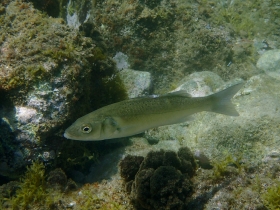PHYPAQ - Physiology of aquatic organisms exploited by fisheries and aquaculture
The scientific concerns of the PhyPAQ team focus on the physiology of aquatic organisms for the development of sustainable aquaculture and fisheries. Research is carried out at different levels of integration, from the molecule to aquatic communities, through species and populations. They contribute to the conservation of aquatic ecosystems and to the rational use of environmentally friendly resources.
The approaches developed by PhyPAQ rely heavily on so-called "omics" techniques: transcriptomic, proteomic and peptidomic. The sequencing of tissue transcriptomes makes it possible to identify bioactive peptides, functional proteins (vitellogenins, amino acid transporters, neuropeptide receptors), but also to access the expression data in a global manner. In silico analysis of transcriptomes associated with identification of mature expression products using mass spectrometry leads to multiple applications in subjects developed by PhyPAQ.
Regardless of the model studied, these approaches offer the opportunity to study finely the processes involved, whether it is the regulation of vitellogenesis in a teleost fish or a cephalopod mollusk, the expression of biomarkers associated with particular metabolic pathways during a food challenge, or the immune response resulting from stress observed in breeding. The power of "omics" approaches associated with in vivo behavioral or in vitro functional tests at the cell or organ level makes it possible to establish the link between the molecular level and the organism. In addition, in addition to the "omics" and mass spectrometry approaches, immunological tests such as ELISA for the sexing of Arapaima gigas spawners, immunocytochemistry for tissue mapping of neuropeptides and behavioral studies on broodstock are implemented routinely.
Axis 1 - Reproduction / Nutrition / Immunity
Through the study of physiological processes, in natural environment and in experimental conditions, this line of research aims to understand the regulatory mechanisms at the molecular level involved in reproduction, in aquaculture nutrition and in immunity. The approaches developed by PhyPAQ rely heavily on the so-called "omics" techniques and target the bioactive peptides involved in the regulation of gametogenesis, egg-laying, intestinal absorption but also the functional proteins associated with these same functions and also to immunity.
The analysis of the expression data obtained in RNAseq makes it possible to make functional assumptions for the different categories of regulatory peptides (neurohormones, pheromones) or to identify regulated metabolic pathways under controlled breeding conditions.
Axis 2 - Sustainable aquaculture and fisheries
Axis 1 provides the methodological tools and the fundamental data which make it possible to envisage a more finalized approach intended to answer very concrete problems to develop sustainable aquaculture and fishing.
By combining various technical approaches, be they molecular, biochemical or functional, this line of research aims for the target aquatic organisms (fish and cephalopods):
1) To develop studies on reproduction in a controlled environment taking into account behavioral aspects and relevant endocrine factors,
2) To understand the mechanisms allowing the meeting of the parents, the emission and the protection of the gametes,
3) To test alternative ingredients to fishmeal for the development of aquaculture feeds as part of a sustainable aquaculture process,
4) To study the physiological mechanisms affected by climate change by taking into account the interactions between the environment-nutrition and the immune system. This knowledge will help to control the breeding conditions of the target species.
The aim of all the research carried out on both axes is to provide the physiological bases for the sustainable development of aquaculture and fishing, in accordance with the United Nations Sustainable Development Goals (SDGs).
Latest scientific articles
2024
-
. 2024. “Influence Of Strains In Development Of Francisellosis In The Blue Mussel Mytilus Edulis During Experimental Challenges”. Aquaculture Reports 36: 102135. doi:10.1016/j.aqrep.2024.102135. https://www.sciencedirect.com/science/article/pii/S2352513424002230.
2023
-
. 2023. “First Isolation Of Francisella Halioticida Strains From Blue Mussel (Mytilus Edulis) In Normandy, France”. Journal Of Invertebrate Pathology 200: 107950. doi:10.1016/j.jip.2023.107950. https://linkinghub.elsevier.com/retrieve/pii/S0022201123000678.
2022
-
. 2022. “Multifaceted Roles Of The Egg Perivitelline Layer In Avian Reproduction: Functional Insights From The Proteomes Of Chicken Egg Inner And Outer Sublayers”. Journal Of Proteomics 258: 104489. doi:10.1016/j.jprot.2022.104489. https://linkinghub.elsevier.com/retrieve/pii/S1874391922000124.
-
. 2022. “Detection Of The Protistan Parasite, Haplosporidium Costale In Crassostrea Gigas Oysters From The French Coast: A Retrospective Study”. Journal Of Invertebrate Pathology 195: 107831. doi:10.1016/j.jip.2022.107831. https://linkinghub.elsevier.com/retrieve/pii/S0022201122001161.
-
. 2022. “Structural And Functional Characterization Of Orcokinin B-Like Neuropeptides In The Cuttlefish (Sepia Officinalis)”. Marine Drugs 20 (8): 505. doi:10.3390/md20080505. https://www.mdpi.com/1660-3397/20/8/505.
-
. 2022. “Immuno-Enzymatic And Proteomic Approaches For Sexing The African Bonytongue (Heterotis Niloticus Cuvier, 1829)”. Fishes 7 (3): 106. doi:10.3390/fishes7030106. https://www.mdpi.com/2410-3888/7/3/106.
-
. 2022. “Identification Of A New Set Of Polypeptidic Sex Pheromones From Cuttlefish (Sepia Officinalis)”. Marine Biotechnology. doi:10.1007/s10126-022-10126-y. https://link.springer.com/10.1007/s10126-022-10126-y.
2021
-
. 2021. “Marine Transcriptomic Analysis For The Identification Of New Antimicrobial Peptides”. Marine Drugs 19 (9): 490. doi:10.3390/md19090490. https://www.mdpi.com/1660-3397/19/9/490.
-
. 2021. “Involvement Of Rfamide Neuropeptides In Polyp Contraction Of The Adult Scleractinian Corals Euphyllia Ancora And Stylophora Pistillata”. General And Comparative Endocrinology 314: 113905. doi:10.1016/j.ygcen.2021.113905. https://linkinghub.elsevier.com/retrieve/pii/S0016648021001982.
2020
-
. 2020. “-Omic Analysis Of The Sepia Officinalis White Body: New Insights Into Multifunctionality And Haematopoiesis Regulation”. Journal Of Proteome Research 19 (8): 3072 - 3087. doi:10.1021/acs.jproteome.0c0010010.1021/acs.jproteome.0c00100.s00110.1021/acs.jproteome.0c00100.s002. https://pubs.acs.org/doi/10.1021/acs.jproteome.0c00100.
Team members
PhD Thesis
Programs
| 2024 | NGSDISPER24 |
| 2024 | ONTOGÉNIE |
| 2024 | ComSac2 |
| 2024 | REGAL2 |
| 2023 | CompRep3 |
| 2023 | REGAL |
| 2022 | CompRep2 |
| 2022 | DOMESNUT |
| 2022 | ACCOLADE |
| 2019 to 2022 | INCIDENCE |
| 2020 | CompRep |
| 2016 to 2020 | LMI EDIA |
| 2020 | OSIRIS |
| 2019 | COLLBAC2 |
| 2019 | SEXMOL |
| 2015 to 2019 | NEMO |
| 2018 to 2019 | SATMAR 3 |
| 2019 | DOMESTOS |
| 2016 to 2019 | PEPTRAQ |
| 2019 | ComSaccu |
| 2017 to 2018 | SATMAR 2 |
| 2014 to 2018 | PetFood 3 |
| 2014 to 2018 | SATMAR 1 |
| 2013 to 2015 | ACTISEP |
| 2012 to 2014 | K4AQUA |
| 2012 to 2014 | PetFood 2 |







